Porcelain Tile Polishing Residue in Concrete as an Additive or Replacement for Portland Cement
Abstract
1. Introduction
2. Experimental Program
2.1. Raw Materials
2.2. Concrete Mix Proportion and Sample Preparation
2.3. Testing Methods
2.4. Binder Index (bi)
2.5. Global Warming Potential
3. Results and Discussion
3.1. Fresh State Properties
3.2. Hardened State Properties
3.2.1. Compressive Strength
3.2.2. Durability Indicators
Water Absorption by Immersion
Water Absorption by Capillarity
Acid Attack Susceptibility
Electrical Resistivity
Carbonation
3.3. CO2 Emission Analysis
3.3.1. Binder Index (bi)
3.3.2. Global Warming Potential
4. Conclusions
- The incorporation of PPR as cement replacement significantly reduced the concrete workability, while this effect was less significant when PPR was incorporated as an additive.
- The concretes with cement replacement by RRP in 10–30% showed equivalent or higher strengths than the reference concrete at 7–91 days. With the addition of PPR, the compressive strength increased for all contents and ages, up to 92% (for 50% addition at 28 days).
- The incorporation of PPR generally improved the durability of concrete (water absorption, capillarity, and acid resistance) and this effect was more pronounced when the waste was incorporated as an additive. In turn, the carbonation depth increased with the partial replacement of cement (as previously reported in the literature for other SCMs), while it slightly decreased with the addition of waste.
- The incorporation of PPR reduced the equivalent emission of CO2 per m³ of concrete for both additive and cement replacement. For a compressive strength of 54 MPa at 91 days, the emission was reduced from 564 kg CO2-eq·m−3 of concrete for the reference mixture to 473 kg CO2-eq·m−3 of concrete (i.e., 16%) for 30% replacement and to 349 kg CO2-eq·m−3 of concrete (i.e., 38%) for 50% addition.
Supplementary Materials
Author Contributions
Funding
Institutional Review Board Statement
Informed Consent Statement
Data Availability Statement
Conflicts of Interest
References
- Scrivener, K.L.; John, V.M.; Gartner, E.M. Eco-Efficient Cements: Potential Economically Viable Solutions for a Low-CO2 Cement-Based Materials Industry. Cem. Concr. Res. 2018, 114, 2–26. [Google Scholar] [CrossRef]
- Santos, H.M.M. Use of Waste from Porcelain Tile Polishing in Concrete as an Addition and as a Supplementary Cementitious Material. Master’s Thesis, Federal University of Pernambuco, Caruaru, Brazil, 2019. (In Portuguese). [Google Scholar]
- De Matos, P.R.; de Oliveira, A.L.; Pelisser, F.; Prudêncio, L.R., Jr. Rheological Behavior of Portland Cement Pastes and Self-Compacting Concretes Containing Porcelain Polishing Residue. Constr. Build. Mater. 2018, 175, 508–518. [Google Scholar] [CrossRef]
- De Matos, P.R.; Prudêncio, L.R.; de Oliveira, A.L.; Pelisser, F.; Gleize, P.J.P. Use of Porcelain Polishing Residue as a Supplementary Cimentitious Material in Self-Compacting Concrete. Constr. Build. Mater. 2018, 193, 623–630. [Google Scholar] [CrossRef]
- Rambaldi, E.; Esposito, L.; Tucci, A.; Timellini, G. Recycling of Polishing Porcelain Stoneware Residues in Ceramic Tiles. J. Eur. Ceram. Soc. 2007, 27, 3509–3515. [Google Scholar] [CrossRef]
- De Matos, P.R.; Jiao, D.; Roberti, F.; Pelisser, F.; Gleize, P.J.P. Rheological and Hydration Behaviour of Cement Pastes Containing Porcelain Polishing Residue and Different Water-Reducing Admixtures. Constr. Build. Mater. 2020, 262, 120850. [Google Scholar] [CrossRef]
- De Souza, P.A.B.F. Estudo Do Comportamento Plástico, Mecânico, Microestrutural e Térmico Do Concreto Produzido Com Resíduo de Porcelanato. Ph.D. Thesis, Federal University of Rio Grande do Norte, Natal, Brazil, 2007. [Google Scholar]
- Steiner, L.R.; Bernardin, A.M.; Pelisser, F. Effectiveness of Ceramic Tile Polishing Residues as Supplementary Cementitious Materials for Cement Mortars. Sustain. Mater. Technol. 2015, 4, 30–35. [Google Scholar] [CrossRef]
- Jacoby, P.C.; Pelisser, F. Pozzolanic Effect of Porcelain Polishing Residue in Portland Cement. J. Clean. Prod. 2015, 100, 84–88. [Google Scholar] [CrossRef]
- Ramos, G.A.; de Matos, P.R.; Pelisser, F.; Gleize, P.J.P. Effect of Porcelain Tile Polishing Residue on Eco-Efficient Geopolymer: Rheological Performance of Pastes and Mortars. J. Build. Eng. 2020, 32, 101699. [Google Scholar] [CrossRef]
- Penteado, C.S.G.; Viviani de Carvalho, E.; Lintz, R.C.C. Reusing Ceramic Tile Polishing Waste in Paving Block Manufacturing. J. Clean. Prod. 2016, 112, 514–520. [Google Scholar] [CrossRef]
- Pacheco-Torgal, F.; Jalali, S. Reusing Ceramic Wastes in Concrete. Constr. Build. Mater. 2010, 24, 832–838. [Google Scholar] [CrossRef]
- Puertas, F.; García-Díaz, I.; Barba, A.; Gazulla, M.F.; Palacios, M.; Gómez, M.P.; Martínez-Ramírez, S. Ceramic Wastes as Alternative Raw Materials for Portland Cement Clinker Production. Cem. Concr. Compos. 2008, 30, 798–805. [Google Scholar] [CrossRef]
- Naceri, A.; Hamina, M.C. Use of Waste Brick as a Partial Replacement of Cement in Mortar. Waste Manag. 2009, 29, 2378–2384. [Google Scholar] [CrossRef] [PubMed]
- Lavat, A.E.; Trezza, M.A.; Poggi, M. Characterization of Ceramic Roof Tile Wastes as Pozzolanic Admixture. Waste Manag. 2009, 29, 1666–1674. [Google Scholar] [CrossRef] [PubMed]
- Cheng, Y.; Huang, F.; Liu, R.; Hou, J.; Li, G. Test Research on Effects of Waste Ceramic Polishing Powder on the Permeability Resistance of Concrete. Mater. Struct. 2016, 49, 729–738. [Google Scholar] [CrossRef]
- Cheng, Y.; Huang, F.; Li, G.; Xu, L.; Hou, J. Test Research on Effects of Ceramic Polishing Powder on Carbonation and Sulphate-Corrosion Resistance of Concrete. Constr. Build. Mater. 2014, 55, 440–446. [Google Scholar] [CrossRef]
- Rodrigues Medeiros, V.B.; Lima, E.E.P.; Carvalho, C.M.; Júnior, A.S.S. Concreto Sustentável Produzido Com Resíduo de Porcelanato: Análise de Durabilidade Por Carbonatação. Rev. Ciência Tecnol. 2018, 17–24. [Google Scholar]
- Wang, G.; Tian, B. Effect of Waste Ceramic Polishing Powder on the Properties of Cement Mortars. In Proceedings of the 2009 International Conference on Energy and Environment Technology, Guilin, China, 16–18 October 2009; pp. 101–104. [Google Scholar]
- Pelisser, F.; Steiner, L.R.; Bernardin, A.M. Recycling of Porcelain Tile Polishing Residue in Portland Cement: Hydration Efficiency. Environ. Sci. Technol. 2012, 46, 2368–2374. [Google Scholar] [CrossRef]
- Wang, G.X.; Xu, K.J.; Zhu, M.Q.; Tian, B. Pozzolanic Activity of Ceramic Polishing Powder as Cementitious Material. Mater. Sci. Forum 2011, 675–677, 135–138. [Google Scholar] [CrossRef]
- Casagrande, C.A.; Jochem, L.F.; Repette, W.L.; Hotza, D. Evaluation of Nano-TiO2 on Properties of Cementitious Mortars. Matéria 2020, 25. [Google Scholar] [CrossRef]
- Li, L.G.; Zhuo, Z.Y.; Kwan, A.K.H.; Zhang, T.S.; Lu, D.G. Cementing Efficiency Factors of Ceramic Polishing Residue in Compressive Strength and Chloride Resistance of Mortar. Powder Technol. 2020, 367, 163–171. [Google Scholar] [CrossRef]
- Li, L.G.; Zhuo, Z.Y.; Zhu, J.; Kwan, A.K.H. Adding Ceramic Polishing Waste as Paste Substitute to Improve Sulphate and Shrinkage Resistances of Mortar. Powder Technol. 2020, 362, 149–156. [Google Scholar] [CrossRef]
- Lee, C.Y.; Wang, S.R. Application of Four-Electrode Method to Analysis Resistance Characteristics of Conductive Concrete. World Acad. Sci. Eng. Technol. 2010, 4, 77–80. [Google Scholar]
- Lavagna, L.; Musso, S.; Ferro, G.; Pavese, M. Cement-Based Composites Containing Functionalized Carbon Fibers. Cem. Concr. Compos. 2018, 88, 165–171. [Google Scholar] [CrossRef]
- Zhu, X.; Zhang, Z.; Yang, K.; Magee, B.; Wang, Y.; Yu, L.; Nanukuttan, S.; Li, Q.; Mu, S.; Yang, C.; et al. Characterisation of Pore Structure Development of Alkali-Activated Slag Cement during Early Hydration Using Electrical Responses. Cem. Concr. Compos. 2018, 89, 139–149. [Google Scholar] [CrossRef]
- Wen, S.; Chung, D.D.L. Effect of Stress on the Electric Polarization in Cement. Cem. Concr. Res. 2001, 31, 291–295. [Google Scholar] [CrossRef]
- Associação Brasileira de Normas Técnicas. NBR 12653—Materiais Pozolânicos—Requisitos; Associação Brasileira de Normas Técnicas: Rio de Janeiro, Brazil, 2015. [Google Scholar]
- Damineli, B.L.; Kemeid, F.M.; Aguiar, P.S.; John, V.M. Measuring the Eco-Efficiency of Cement Use. Cem. Concr. Compos. 2010, 32, 555–562. [Google Scholar] [CrossRef]
- Associação Brasileira de Normas Técnicas. NBR 5738—Concreto—Procedimento Para Moldagem e Cura de Corpos de Prova; Associação Brasileira de Normas Técnicas: Rio de Janeiro, Brazil, 2016. [Google Scholar]
- Associação Brasileira de Normas Técnicas. NBR NM 67—Concreto—Determinação Da Consistência Pelo Abatimento Do Tronco de Cone; Associação Brasileira de Normas Técnicas: Rio de Janeiro, Brazil, 1998. [Google Scholar]
- Associação Brasileira de Normas Técnicas. NBR 5739—Concreto—Ensaio de Compressão de Corpos de Prova Cilíndricos; Associação Brasileira de Normas Técnicas: Rio de Janeiro, Brazil, 2018. [Google Scholar]
- Associação Brasileira de Normas Técnicas. NBR 9778—Argamassa e Concreto Endurecidos—Determinação Da Absorção de Água, Índice de Vazios e Massa Específica; Associação Brasileira de Normas Técnicas: Rio de Janeiro, Brazil, 2005. [Google Scholar]
- Associação Brasileira de Normas Técnicas. NBR 9779—Argamassa e Concreto Endurecidos—Determinação Da Absorção de Água Por Capilaridade; Associação Brasileira de Normas Técnicas: Rio de Janeiro, Brazil, 2012. [Google Scholar]
- Associação Brasileira de Normas Técnicas. NBR 10005 Procedimento Para Obtenção de Extrato Lixiviado de Resíduos Sólido; ABNT: Rio de Janeiro, Brazil, 2004. [Google Scholar]
- Flower, D.J.M.; Sanjayan, J.G. Green House Gas Emissions Due to Concrete Manufacture. Int. J. Life Cycle Assess. 2007, 12, 282–288. [Google Scholar] [CrossRef]
- Cassagnabère, F.; Mouret, M.; Escadeillas, G.; Broilliard, P.; Bertrand, A. Metakaolin, a Solution for the Precast Industry to Limit the Clinker Content in Concrete: Mechanical Aspects. Constr. Build. Mater. 2010, 24, 1109–1118. [Google Scholar] [CrossRef]
- Liu, R.; Durham, S.A.; Rens, K.L.; Ramaswami, A. Optimization of Cementitious Material Content for Sustainable Concrete Mixtures. J. Mater. Civ. Eng. 2012, 24, 745–753. [Google Scholar] [CrossRef]
- Turner, L.K.; Collins, F.G. Carbon Dioxide Equivalent (CO2-e) Emissions: A Comparison between Geopolymer and OPC Cement Concrete. Constr. Build. Mater. 2013, 43, 125–130. [Google Scholar] [CrossRef]
- Celik, K.; Meral, C.; Petek Gursel, A.; Mehta, P.K.; Horvath, A.; Monteiro, P.J.M. Mechanical Properties, Durability, and Life-Cycle Assessment of Self-Consolidating Concrete Mixtures Made with Blended Portland Cements Containing Fly Ash and Limestone Powder. Cem. Concr. Compos. 2015, 56, 59–72. [Google Scholar] [CrossRef]
- Zhong, M.F.; Su, D.G.; Zhao, Y.X. Hydration Activity of Ceramic Polishing Powder at Autoclaved Condition. Adv. Mater. Res. 2012, 568, 392–395. [Google Scholar] [CrossRef]
- Roberti, F.; Cesari, V.F.; de Matos, P.R.; Pelisser, F.; Pilar, R. High- and Ultra-High-Performance Concrete Produced with Sulfate-Resisting Cement and Steel Microfiber: Autogenous Shrinkage, Fresh-State, Mechanical Properties and Microstructure Characterization. Constr. Build. Mater. 2021, 268, 121092. [Google Scholar] [CrossRef]
- Jochem, L.F.; Casagrande, C.A.; Bizinotto, M.B.; Aponte, D.; Rocha, J.C. Study of the Solidification/Stabilization Process in a Mortar with Lightweight Aggregate or Recycled Aggregate. J. Clean. Prod. 2021, 281, 129415. [Google Scholar] [CrossRef]
- Berodier, E.; Scrivener, K. Understanding the Filler Effect on the Nucleation and Growth of C-S-H. J. Am. Ceram. Soc. 2014, 97, 3764–3773. [Google Scholar] [CrossRef]
- Jochem, L.F.; Rocha, J.C.; Cheriaf, M. The Influence of Fine Sand from Construction-Demolition Wastes (CDW) in the Mortar Properties. In Key Engineering Materials; Trans Tech Publications Ltd.: Zurich, Switzerland, 2014; Volume 600, pp. 357–366. [Google Scholar] [CrossRef]
- Breitenbach, S.B.; Santos, O.C.; Andrade, J.C.S.; Nascimento, R.M.; Martinelli, A.E. Adição de Resíduo Do Polimento de Porcelanato Em Argamassas de Restauro à Base de Cal. Cerâmica 2017, 63, 395–401. [Google Scholar] [CrossRef]
- Oueslati, O.; Duchesne, J. The Effect of SCMs on the Corrosion of Rebar Embedded in Mortars Subjected to an Acetic Acid Attack. Cem. Concr. Res. 2012, 42, 467–475. [Google Scholar] [CrossRef]
- Oueslati, O. Durabilité des Matériaux Cimentaires Soumis Aux Acides Organiques; Université Laval: Quebec, QC, Canada, 2011. [Google Scholar]
- Donatello, S.; Palomo, A.; Fernández-Jiménez, A. Durability of Very High Volume Fly Ash Cement Pastes and Mortars in Aggressive Solutions. Cem. Concr. Compos. 2013, 38, 12–20. [Google Scholar] [CrossRef]
- Chatveera, B.; Lertwattanaruk, P. Evaluation of Nitric and Acetic Acid Resistance of Cement Mortars Containing High-Volume Black Rice Husk Ash. J. Environ. Manag. 2014, 133, 365–373. [Google Scholar] [CrossRef]
- Mehta, P.K.; Monteiro, P.J. Concreto: Microestrutura, Propriedades e Materiais; IBRACON: São Paolo, Brazil, 2008. [Google Scholar]
- Safiuddin, M.; West, J.S.; Soudki, K.A. Hardened Properties of Self-Consolidating High Performance Concrete Including Rice Husk Ash. Cem. Concr. Compos. 2010, 32, 708–717. [Google Scholar] [CrossRef]
- De Matos, P.R.; Sakata, R.D.; Prudêncio, L.R. Eco-Efficient Low Binder High-Performance Self-Compacting Concretes. Constr. Build. Mater. 2019, 225, 941–955. [Google Scholar] [CrossRef]
- Pelisser, F.; Vieira, A.; Bernardin, A.M. Efficient Self-Compacting Concrete with Low Cement Consumption. J. Clean. Prod. 2018, 175, 324–332. [Google Scholar] [CrossRef]
- John, V.M. Concreto: Ciência e Tecnologia, 1st ed.; Isaia, G.C., Ed.; IBRACON: São Paulo, Brazil, 2011; Volume 2. [Google Scholar]


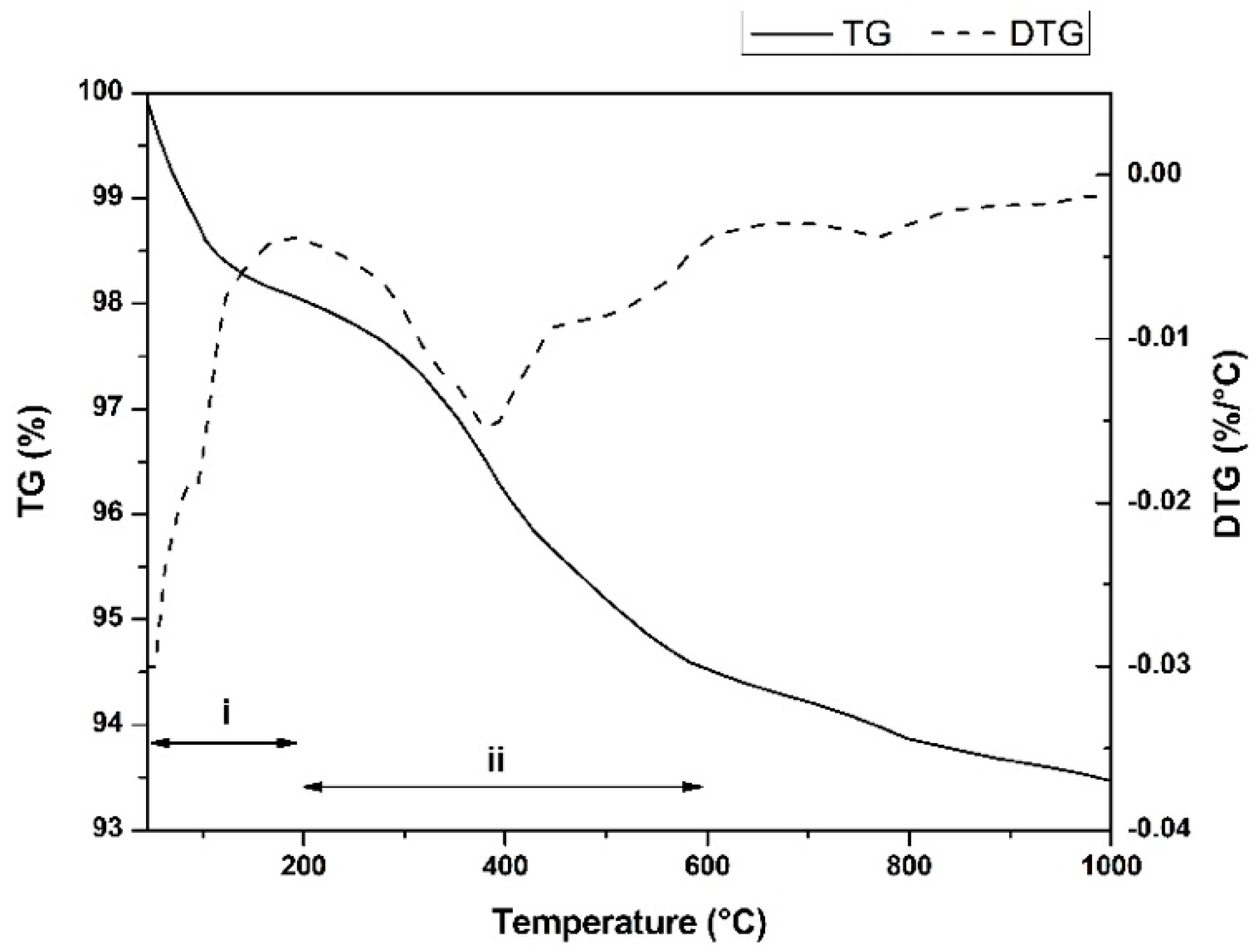
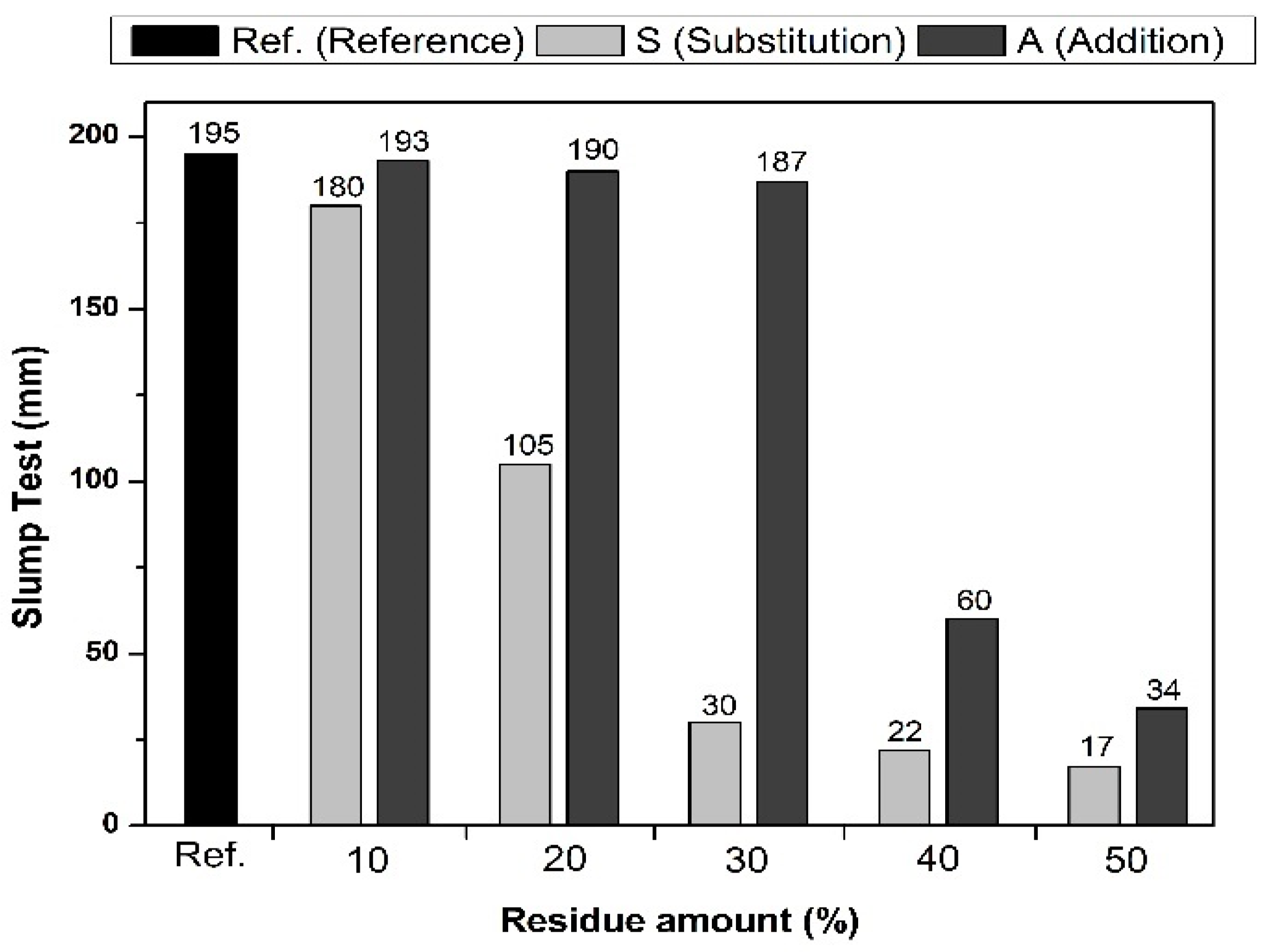

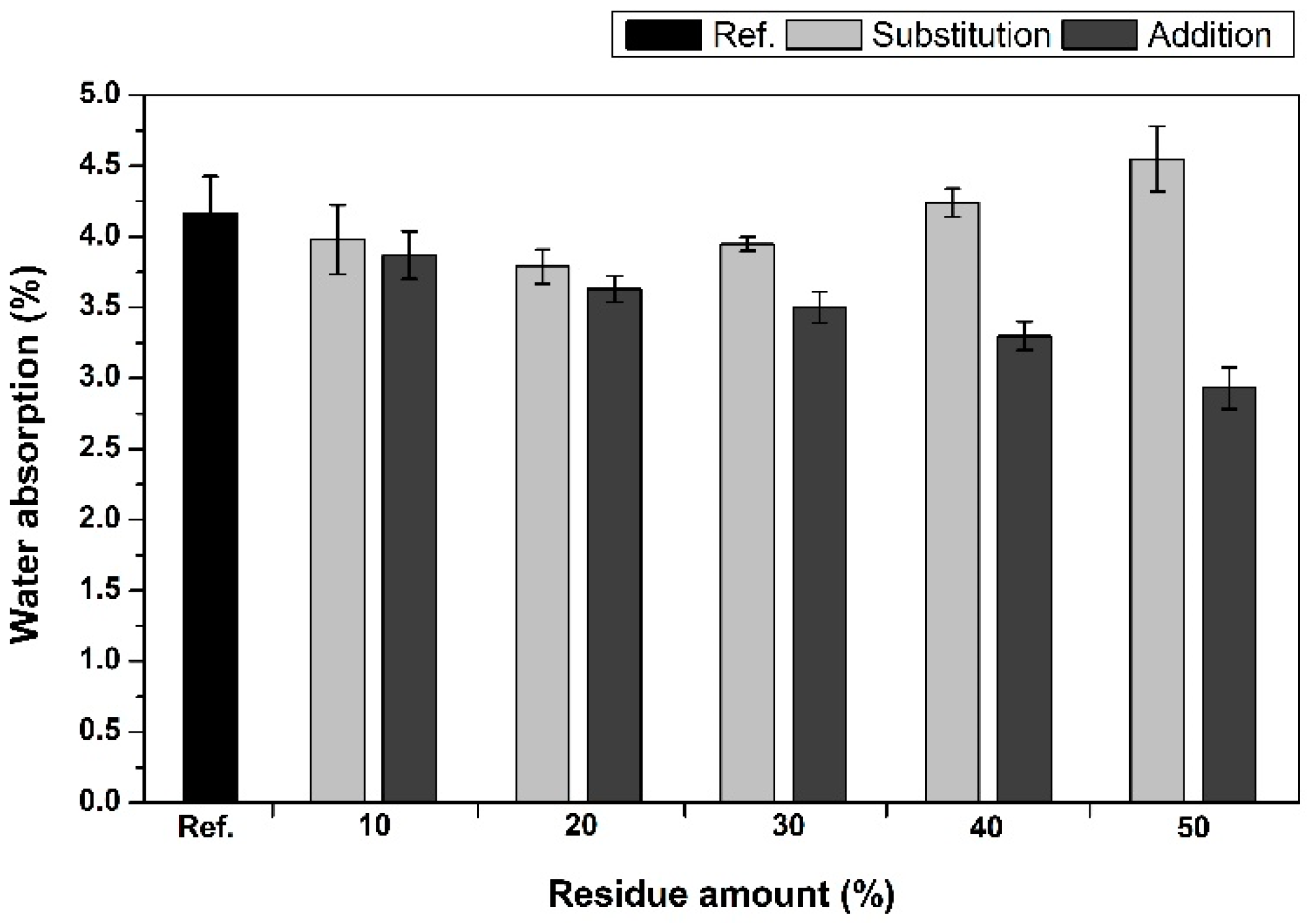
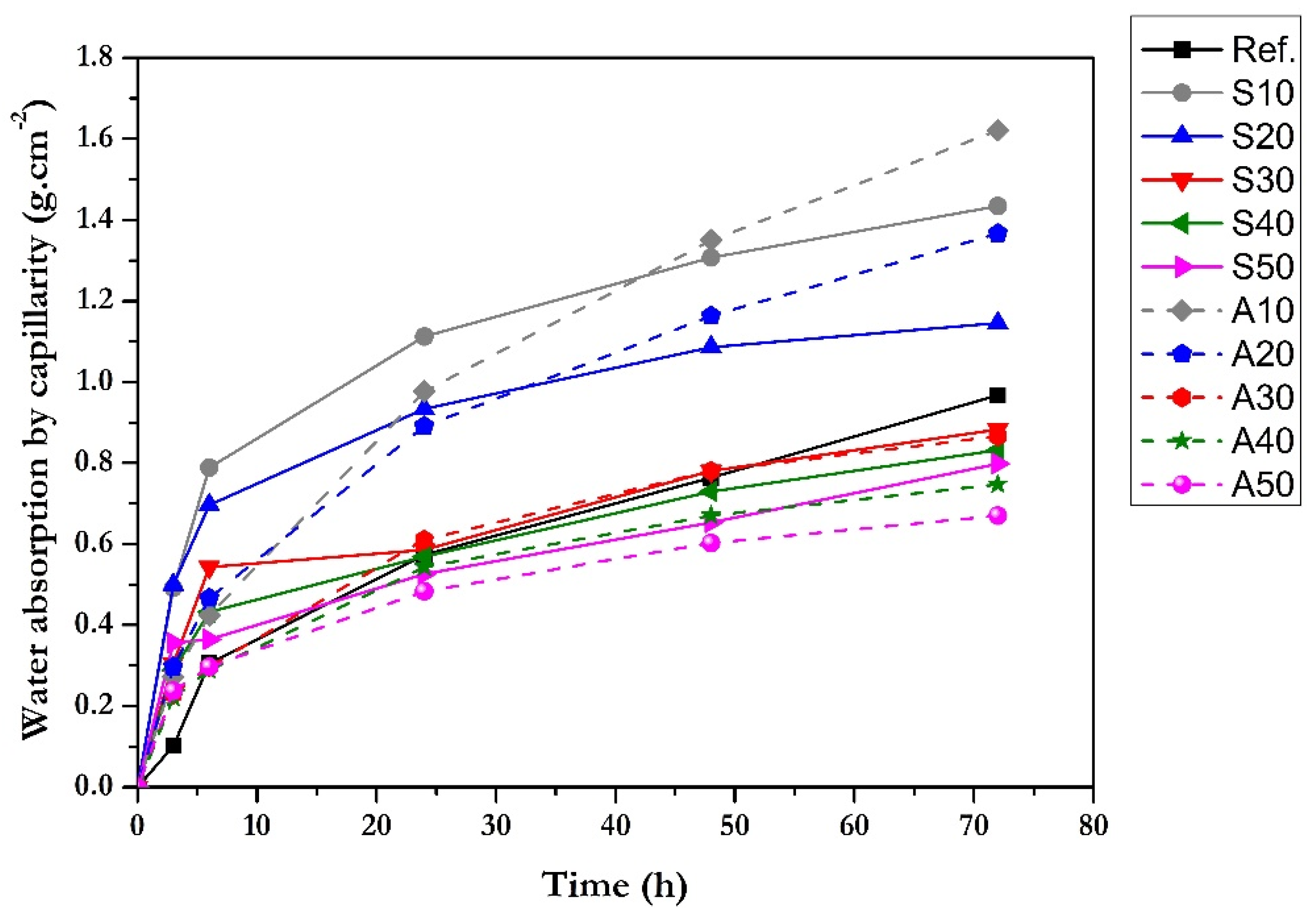


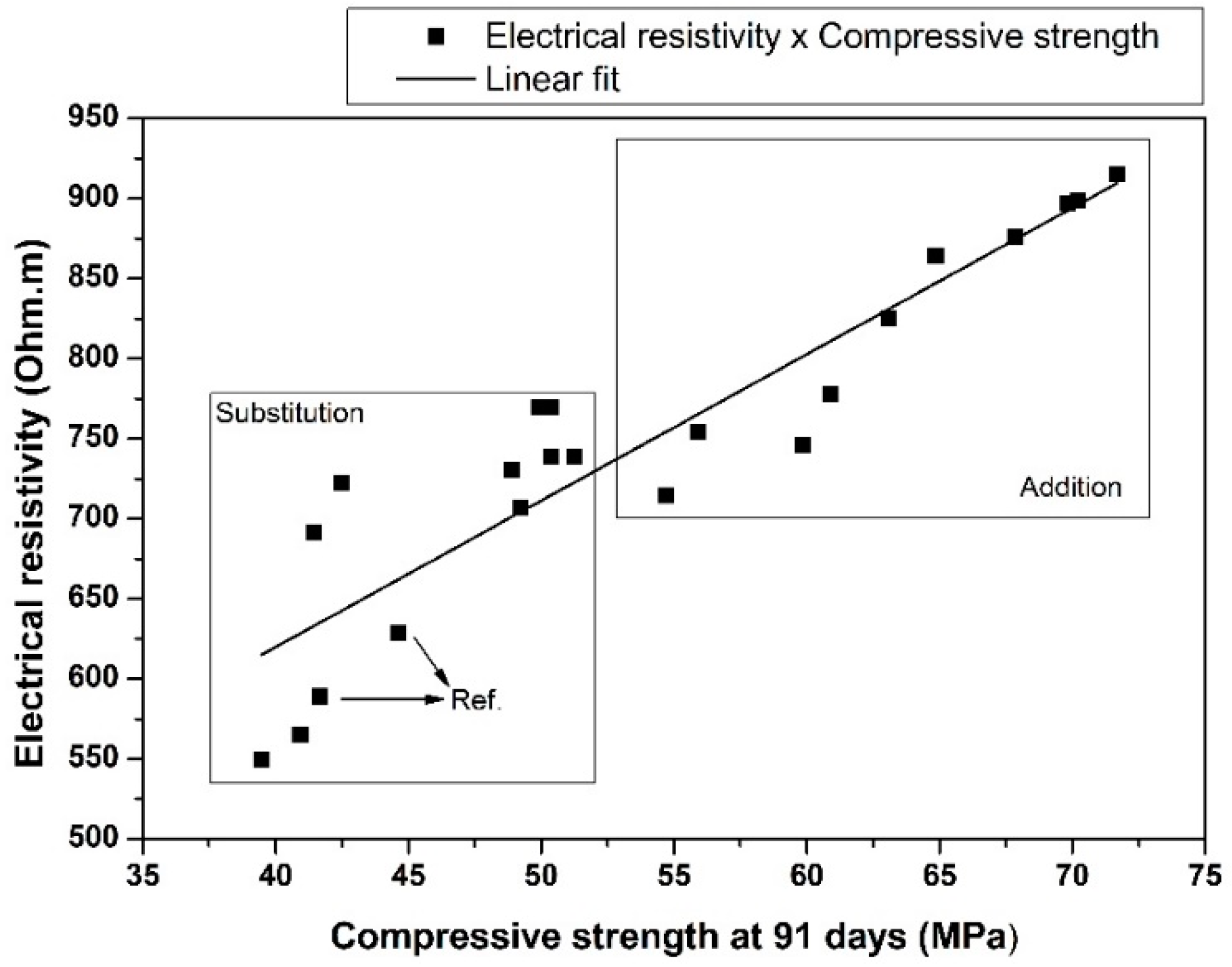
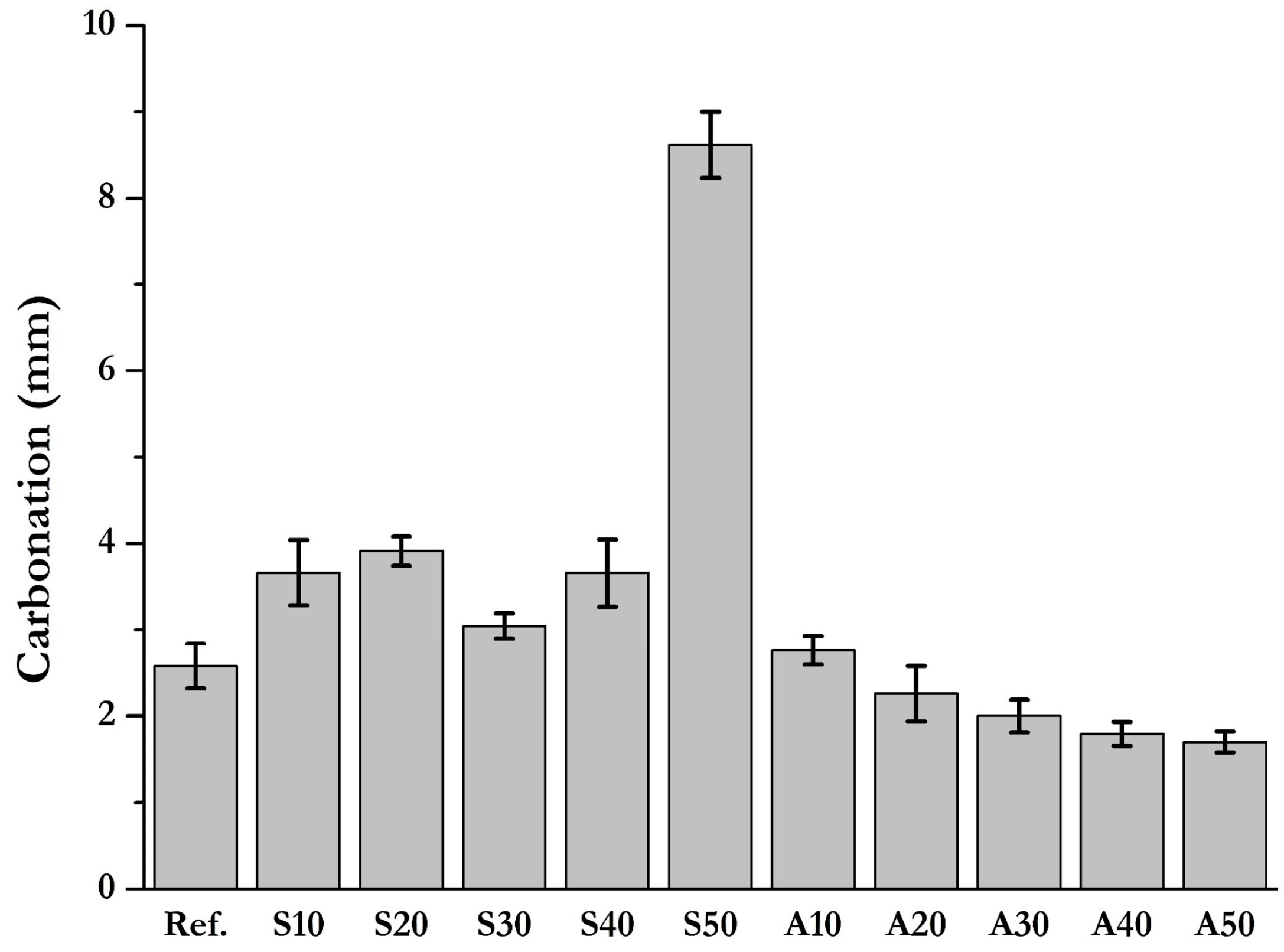
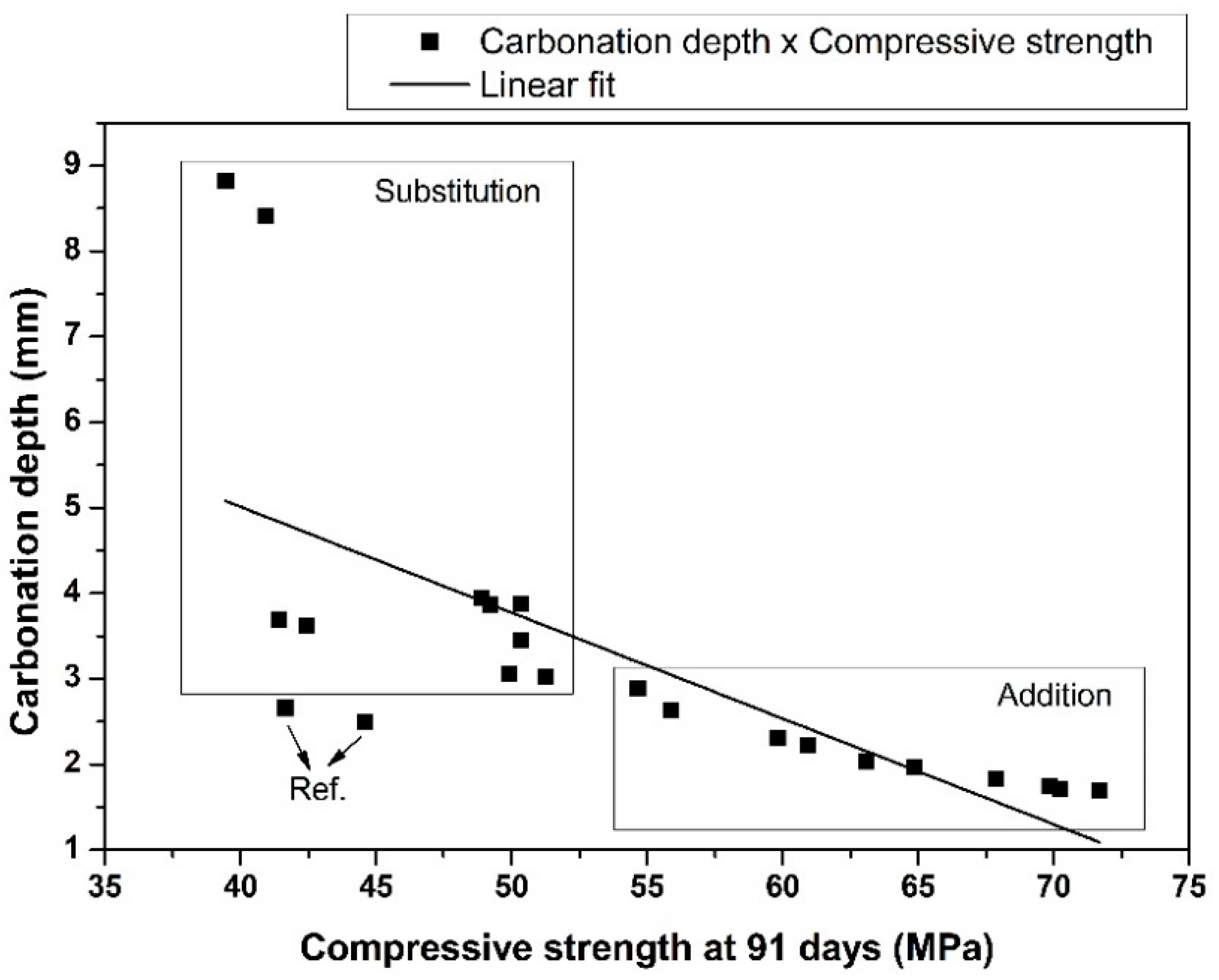

| Property/Material | PC | PPR |
|---|---|---|
| Average diameter (µm) | 19.20 | 14.32 |
| BET specific surface area (m2·g−1) | 1900 | 2790 |
| Blaine fineness (m2·g−1) | 479.7 | - |
| Density (g·cm−3) | 3.09 | 2.48 |
| Oxides (wt.%) | SiO2 | Al2O3 | Fe2O3 | CaO | SO3 | MgO | K2O | LOI |
|---|---|---|---|---|---|---|---|---|
| (%) | 64.32 | 19.23 | 0.94 | 1.71 | 0.10 | 10.32 | 2.80 | - |
| Cement | Sand | Gravel | PPR | Water * | Superplasticizer | |
|---|---|---|---|---|---|---|
| REF | 1.00 | 1.94 | 2.62 | - | 0.50 | 0.010 |
| S10 | 0.90 | 1.92 | 2.62 | 0.10 | 0.50 | 0.010 |
| S20 | 0.80 | 1.90 | 2.62 | 0.20 | 0.50 | 0.010 |
| S30 | 0.70 | 1.88 | 2.62 | 0.30 | 0.50 | 0.020 |
| S40 | 0.60 | 1.85 | 2.62 | 0.40 | 0.50 | 0.025 |
| S50 | 0.50 | 1.83 | 2.62 | 0.50 | 0.50 | 0.025 |
| A10 | 1.00 | 1.84 | 2.62 | 0.10 | 0.50 | 0.010 |
| A20 | 1.00 | 1.73 | 2.62 | 0.20 | 0.50 | 0.010 |
| A30 | 1.00 | 1.63 | 2.62 | 0.30 | 0.50 | 0.010 |
| A40 | 1.00 | 1.53 | 2.62 | 0.40 | 0.50 | 0.010 |
| A50 | 1.00 | 1.42 | 2.62 | 0.50 | 0.50 | 0.010 |
| Concrete | bi (kg·m−3·MPa−1) | Binder (kg·m−3) | Cement (kg·m−3) | PPR (kg·m−3) | GWP (CO2-eq·m−3 of Concrete) | GWP Reduction |
|---|---|---|---|---|---|---|
| Ref | 9.04 | 488.02 | 488.02 | 0.00 | 564.01 | 0.00% |
| S10 | 8.63 | 466.17 | 419.55 | 46.62 | 494.17 | −12.38% |
| S20 | 9.47 | 511.39 | 409.11 | 102.28 | 492.96 | −12.60% |
| S30 | 10.05 | 542.82 | 379.97 | 162.85 | 473.05 | −16.13% |
| S40 | 13.03 | 703.56 | 422.14 | 281.42 | 545.99 | −3.20% |
| S50 | 14.57 | 786.72 | 393.36 | 393.36 | 534.38 | −5.25% |
| A10 | 7.78 | 420.40 | 382.18 | 38.22 | 443.37 | −21.39% |
| A20 | 7.74 | 418.05 | 348.38 | 69.68 | 405.52 | −28.10% |
| A30 | 7.92 | 427.67 | 328.98 | 98.69 | 384.19 | −31.88% |
| A40 | 7.95 | 429.40 | 306.71 | 122.68 | 359.38 | −36.28% |
| A50 | 8.24 | 444.94 | 296.63 | 148.31 | 348.66 | −38.18% |
Disclaimer/Publisher’s Note: The statements, opinions and data contained in all publications are solely those of the individual author(s) and contributor(s) and not of MDPI and/or the editor(s). MDPI and/or the editor(s) disclaim responsibility for any injury to people or property resulting from any ideas, methods, instructions or products referred to in the content. |
© 2023 by the authors. Licensee MDPI, Basel, Switzerland. This article is an open access article distributed under the terms and conditions of the Creative Commons Attribution (CC BY) license (https://creativecommons.org/licenses/by/4.0/).
Share and Cite
Santos, H.M.M.; Jochem, L.F.; de Matos, P.R.; Casagrande, C.A.; Marinho, É.P.; Szeląg, M.; de Nóbrega, A.C.V. Porcelain Tile Polishing Residue in Concrete as an Additive or Replacement for Portland Cement. Appl. Sci. 2023, 13, 2824. https://doi.org/10.3390/app13052824
Santos HMM, Jochem LF, de Matos PR, Casagrande CA, Marinho ÉP, Szeląg M, de Nóbrega ACV. Porcelain Tile Polishing Residue in Concrete as an Additive or Replacement for Portland Cement. Applied Sciences. 2023; 13(5):2824. https://doi.org/10.3390/app13052824
Chicago/Turabian StyleSantos, Humberto Mycael Mota, Lidiane Fernanda Jochem, Paulo Ricardo de Matos, Cézar Augusto Casagrande, Érika Pinto Marinho, Maciej Szeląg, and Ana Cecília Vieira de Nóbrega. 2023. "Porcelain Tile Polishing Residue in Concrete as an Additive or Replacement for Portland Cement" Applied Sciences 13, no. 5: 2824. https://doi.org/10.3390/app13052824
APA StyleSantos, H. M. M., Jochem, L. F., de Matos, P. R., Casagrande, C. A., Marinho, É. P., Szeląg, M., & de Nóbrega, A. C. V. (2023). Porcelain Tile Polishing Residue in Concrete as an Additive or Replacement for Portland Cement. Applied Sciences, 13(5), 2824. https://doi.org/10.3390/app13052824








